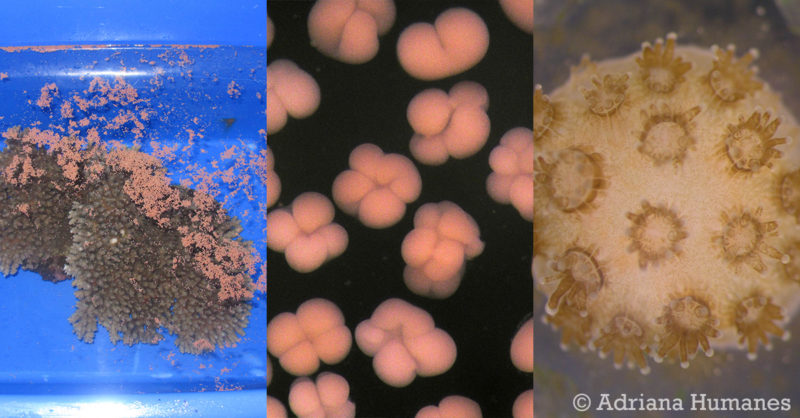Now that we’ve covered the basics of what constitutes a coral and how to tell the difference between soft and hard varieties, we’ll delve deeper into hard-coral biology. If you aren’t sure exactly what constitutes a coral, refer to “Coral Identification: Part I” and then come back to this article.
Small and Large Polyp Corals
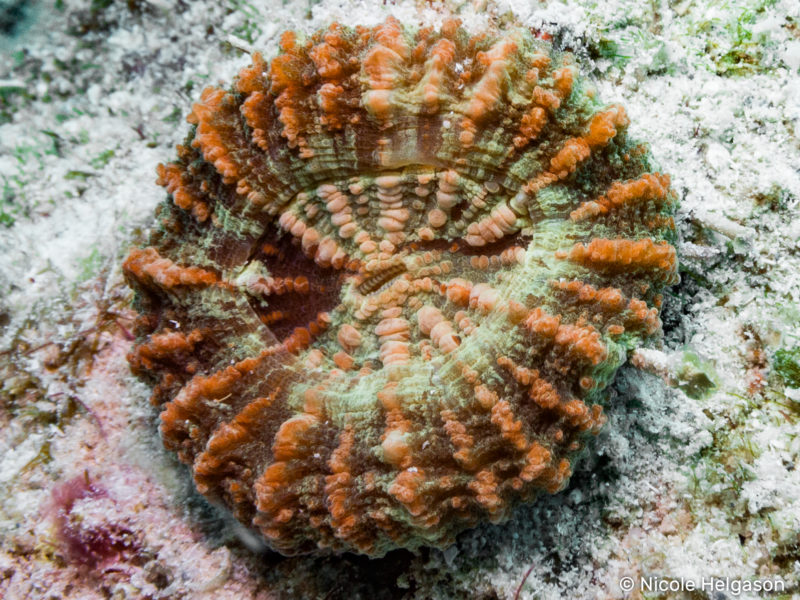
There are two categories of hard coral, divided by polyp size. The first is small-polyp stony corals, or SPS; the second is large-polyp stony corals, or LPS. Both types have hard skeletons, but LPS corals have large, fleshy polyps which, when inflated, obstruct the hard skeleton. This means some divers mistake them for soft corals.
A single large polyp, or colonies of large polyps can make up LPS corals. SPS corals have small polyps embedded in a hard-coral skeleton, and multiple polyps will form a colony. While it is less important to classify corals as SPS or LPS, is it important to recognize that LPS corals can be mistaken for soft corals.
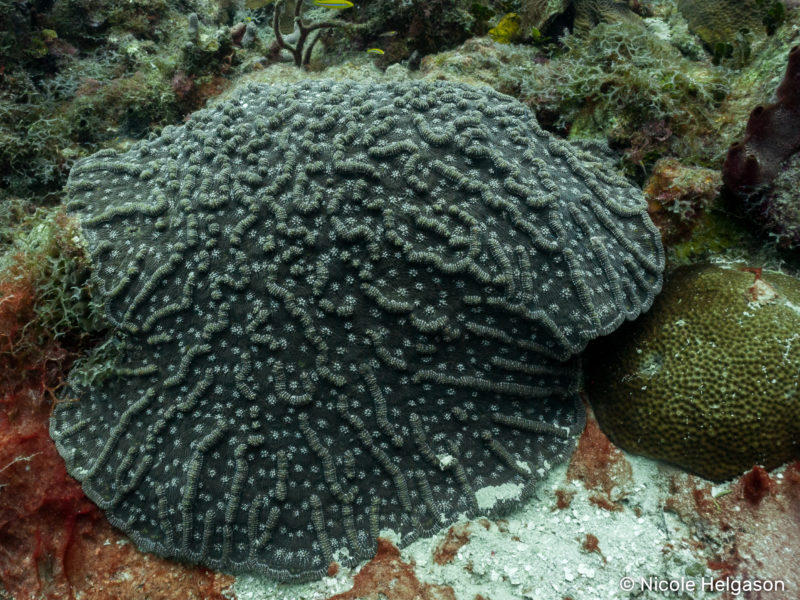
SPS corals are the most recognizable as hard corals because you can see a hard skeleton. If you are unsure if something is an LPS hard coral or just a soft coral, try to look underneath the coral to see if there is a skeleton. Alternately, check for signs of a hard skeleton below the fleshy polyps, like skeletal teeth beneath inflated tissue.
Corals appearing soft and fleshy, which are encrusting on a rock or forming a plate are always going to be hard corals. There are no encrusting or plating soft coral species.
Coral Reproduction
Corals can reproduce both sexually and asexually. Once a year during annual coral-spawning events, corals will release eggs and sperm, which meet in the water column to form coral gametes. These gametes divide and metamorphose into free-swimming coral larvae, which actively seek a suitable location to settle on the reef.
Once the larvae reach the seafloor, they will attach to the substrate and start developing into a coral polyp. From here the single polyp will start forming a hard skeleton, firmly attached at the base. The single polyp then starts to divide, forming genetically identical polyps around the primary polyp. Over time, these polyps each form their own hard skeleton and continue dividing. Eventually, hundreds of polyps will live together, forming a colony.
It can take a year before a single polyp has divided into a few dozen polyps and grown to the size of quarter. During the initial development of a coral larvae, the tiny polyp must contend with encroaching corals, algae, and grazing animals with coral-crushing beaks, such as parrotfish.
It’s a tough life for a baby coral, which is why asexual reproduction is an important aspect of coral biology as well. Corals are colonial animals, meaning that hundreds of individual polyps form a coral skeleton and live as one unit. If a fragment of coral breaks off from the main colony, the fragment will continue to grow.
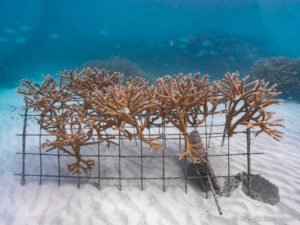 Coral restoration projects like the one shown above take advantage of this reproduction method by separating mother colonies into smaller fragments. Project administrators tend these fragments in a nursery and then transplant them to help restore a degraded reef environment. Grazing fish, turtles, and other marine life also break pieces of coral off from the mother colony, and these may establish themselves nearby as well.
Coral restoration projects like the one shown above take advantage of this reproduction method by separating mother colonies into smaller fragments. Project administrators tend these fragments in a nursery and then transplant them to help restore a degraded reef environment. Grazing fish, turtles, and other marine life also break pieces of coral off from the mother colony, and these may establish themselves nearby as well.
Helpful Coral Terms for Identification
To identify coral, it’s best to know some of the scientific terms associated with this animal.
Corals are classified by genus and species, and there can be multiple species within a genus. When you are trying to identify a coral it is easier to start with the genus.
For example, Acropora is a genus and cervicornis (staghorn) is the species. There are over a hundred unique Acropora species, each with unique characteristics. Once you’ve mastered identifying corals by genus it will be much easier to narrow down species.
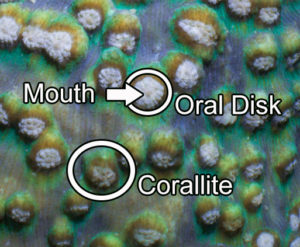 Stony-coral polyps have a mouth and an oral disk, which is often a different color from the coral tissue. Polyps build hard calcium-carbonate skeletons, and the first structure a polyp builds is called the corallite, which is where the polyp lives. Corallite size and structure can help narrow down identification, especially in corals of similar appearance.
Stony-coral polyps have a mouth and an oral disk, which is often a different color from the coral tissue. Polyps build hard calcium-carbonate skeletons, and the first structure a polyp builds is called the corallite, which is where the polyp lives. Corallite size and structure can help narrow down identification, especially in corals of similar appearance.
The top of the corallite wall is called a ridge; between ridges are valleys. Some corals have shared walls while others feature a clear distinction between two corallite walls. Some corals will have distinct corallite walls while others will have underdeveloped or no walls at all.
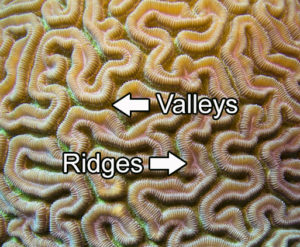 First, identify the corallite and note its size. Once you can identify corallites, features like shared walls, valleys and ridges will help you distinguish between different species in the same genus.
First, identify the corallite and note its size. Once you can identify corallites, features like shared walls, valleys and ridges will help you distinguish between different species in the same genus.
Ridges, valleys, walls, corallites, and growth forms are all important clues to identification. As you become more familiar with corals and are ready to tease apart individual species, these terms will be more important.
Coral Hub is a great online resource for learning more coral terms. This video also explains these terms in more detail.
Coral growth forms
Recognizing coral growth forms is one of the most effective ways to narrow down species and genus. Corals grow in several unique forms, including branching, encrusting, plating, massive, and solitary. Within these groups there are large and small polyp types, as well as various corallite arrangements. Identifying coral growth forms also goes a long way to knowing what you’re looking at.
In our next article, we’ll discuss underwater photography as an effective way to start identifying corals. If you don’t have an underwater camera, online coral guides can help you memorize distinct coral types.
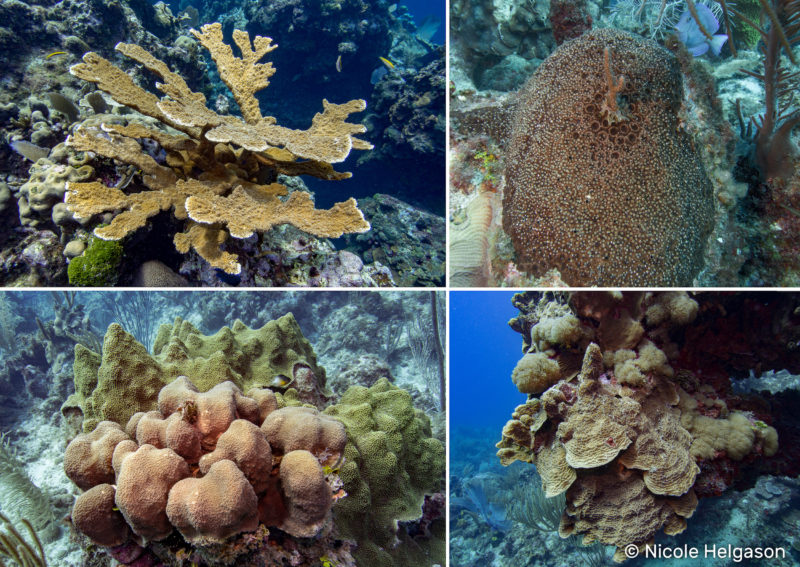
Nicole Helgason is a PADI Dive Instructor with nine years of professional dive experience. She has taught scuba diving in Canada, Dominican Republic and Indonesia, and has managed dive centers in Mozambique and Baja, Mexico. Nicole has a bachelor’s degree in coastal geography from the University of Victoria and is passionate about coral restoration and coral reefs. She has a website, Facebook, Instagram and Twitter accounts.


